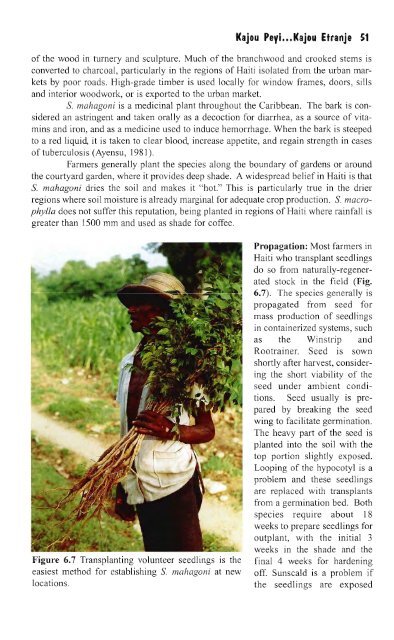Important Trees of Haiti
Important Trees of Haiti
Important Trees of Haiti
Create successful ePaper yourself
Turn your PDF publications into a flip-book with our unique Google optimized e-Paper software.
Kajou Peyi... Kajou Etranje S1<br />
<strong>of</strong> the wood in turnery and sculpture. Much <strong>of</strong> the branchwood and crooked stems is<br />
converted to charcoal, particularly in the regions <strong>of</strong> <strong>Haiti</strong> isolated from the urban markets<br />
by poor roads. High-grade timber is used locally for window frames, doors, sills<br />
and interior woodwork, or is exported to the urban market.<br />
S. mahagoni is a medicinal plant throughout the Caribbean. The bark is considered<br />
an astringent and taken orally as a decoction for diarrhea, as a source <strong>of</strong> vitamins<br />
and iron, and as a medicine used to induce hemorrhage. When the bark is steeped<br />
to a red liquid, it is taken to clear blood, increase appetite, and regain strength in cases<br />
<strong>of</strong> tuberculosis (Ayensu, 1981).<br />
Farmers generally plant the species along the boundary <strong>of</strong> gardens or around<br />
the courtyard garden, where it provides deep shade. A widespread belief in <strong>Haiti</strong> is that<br />
S. mahagoni dries the soil and makes it "hot." This is particularly true in the drier<br />
regions where soil moisture is already marginal for adequate crop production. S. macrophylla<br />
does not suffer this reputation, being planted in regions <strong>of</strong> <strong>Haiti</strong> where rainfall is<br />
greater than 1500 mm and used as shade for c<strong>of</strong>fee.<br />
Figure 6.7 Transplanting volunteer seedlings is the<br />
easiest method for establishing S. mahagoni at new<br />
locations.<br />
Propagation: Most farmers in<br />
<strong>Haiti</strong> who transplant seedlings<br />
do so from naturally-regenerated<br />
stock in the field (Fig.<br />
6.7). The species generally is<br />
propagated from seed for<br />
mass production <strong>of</strong> seedlings<br />
in containerized systems, such<br />
as the Winstrip and<br />
Rootrainer. Seed is sown<br />
shortly after harvest, considering<br />
the short viability <strong>of</strong> the<br />
seed under ambient conditions.<br />
Seed usually is prepared<br />
by breaking the seed<br />
wing to facilitate germination.<br />
The heavy part <strong>of</strong> the seed is<br />
planted into the soil with the<br />
top portion slightly exposed.<br />
Looping <strong>of</strong> the hypocotyl is a<br />
problem and these seedlings<br />
are replaced with transplants<br />
from a germination bed. Both<br />
species require about 18<br />
weeks to prepare seedlings for<br />
outplant, with the initial 3<br />
weeks in the shade and the<br />
final 4 weeks for hardening<br />
<strong>of</strong>f. Sunscald is a problem if<br />
the seedlings are exposed

















